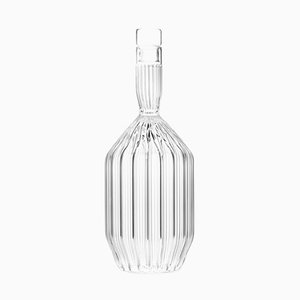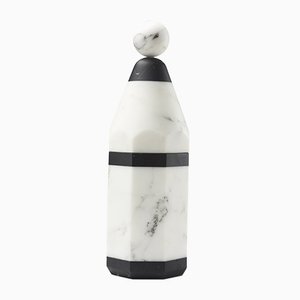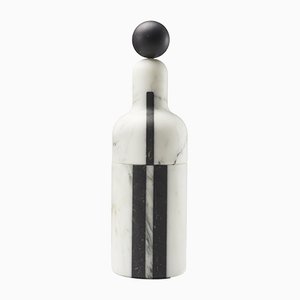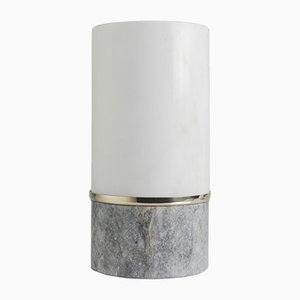Grand Prix winner Sara de Campos on her solo show at this year's Design Parade Hyères
Inspired by the Everyday
The work of Lisbon-based designer Sara de Campos stands out for its discrete functionalism; a result of her obsessive propencity for questioning the utility of existing objects to find new solutions to everyday problems. Last year, the ECAL graduate gained recognition by winning the Design Parade’s prestigious Grand Prix with her UVA design project, which centered on improvements to grape harvesting. Born into a family of winemakers, Sara used careful research to design a container and transport system that boost the pickers’ comfort and better preserve the quality of the grapes. This year in Hyères, Sara's presenting a solo exhibition themed around food generally, and more specifically the Mediterranean diet. The show features glass and porcelain objects that Sara made at the CIRVA glass research center and the renowned Sèvres porcelain factory—through workshops organized as a part of last year's Grand Prix award.
To celebrate this year's edition of Design Parade, we had the joy of catching up with Sara to learn more about her unique approach as well her experience with the festival. Be sure to check out Sara's posts in our Instagram stories this week!
Audrey Kadjar: Last year, you won Design Parade’s Grand Prix for a project about grape harvesting. What were the project’s goals and inspirations?
Sara de Campos: The harvesting of grapes for winemaking takes place once a year—all over the world. Millions of grapes are picked by workers in only a few weeks, but collecting big quantities can be quite painful. This process also deteriorates the grapes’ condition, because they are thrown into the truck and smashed, which triggers fermentation. Considering these problems, I designed Uva. The picker can easily drop the container onto the edge of the truck, which preserves the grapes’ condition. This tool is also comfortable for the pickers thanks to its ergonomic support and textile cover.
AK: How did you conceive your solo exhibition for this year's edition of Design Parade Hyères?
SdC: My solo exhibition is centered around food and how we interact with it. It was inspired by the Mediterranean diet and its key components like olive oil, fruits, vegetables, and bread. Titled Mediterranean Table, the show includes objects in both glass and porcelain that I made at CIRVA and at the Manufacture de Sèvres.
AK: Your education background includes studies in product design, photography, and music. How do other disciplines influence your design practice?
SdC: I think other disciplines gave me tools and a certain freedom that are useful for my product design work. Photography, in particular, encourages me to perfect the details of an object and use a practical and formal approach, as it is essential to document and communicate projects.
AK: What informs your design approach?
SdC: I am interested in the context of products and researching how are we be able to improve something ergonomically or on a production level. Visual balance, materiality, colors, and details also very important to me.
AK: What are your main inspirations?
SdC: Daily life inspires me. I also like to expand my interests by exploring fields other than furniture, such as agriculture.
AK: What are your future plans?
SdC: As a designer, I hope to be able to continue doing what I really like—working as an independent studio and participating in industrial and product design projects that aim at improving our quality of life. In the short term, I will collaborate on the development of a light project with French brand Sammode; work on several objects that will be on view next year at a furniture fair; and pursue a photography project.
Design Parade Hyères takes place from June 28-30; its exhibitions are on view at the Villa Noailles from June 28 to September 29, 2019.
-
Text by
-
Audrey Kadjar
Born in the US to a French family, Audrey grew up in multiple countries. Before landing at Pamono, she studied art history in London and worked in the cultural industry. When she's not working at Pamono, she can be found pursuing art and photography projects.
-
More to Love
Margot White Wine Goblets by Felicia Ferrone for fferrone, Set of 2

Margot Decanter by Felicia Ferrone

ULISSE Wine Set by Manufatto, 2017, Set of 3

Coolers A Bottle Cooler by Pietro Russo for Editions Milano, 2017

Coolers B Bottle Cooler by Pietro Russo for Editions Milano, 2017

Coolers C Bottle Cooler by Pietro Russo for Editions Milano, 2017

Coolers D Bottle Cooler by Pietro Russo for Editions Milano, 2017

White Ice Ice Baby Bucket by Lorenza Bozzoli for Editions Milano, 2017

Black Ice Ice Baby Bucket by Lorenza Bozzoli for Editions Milano

Cheima Wine Cooler by Mono Rocks


